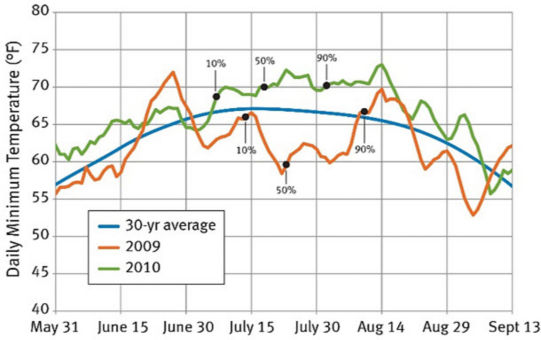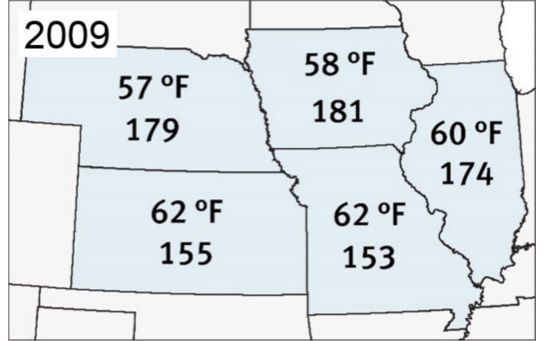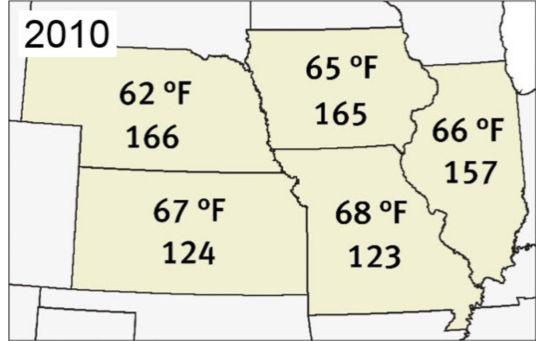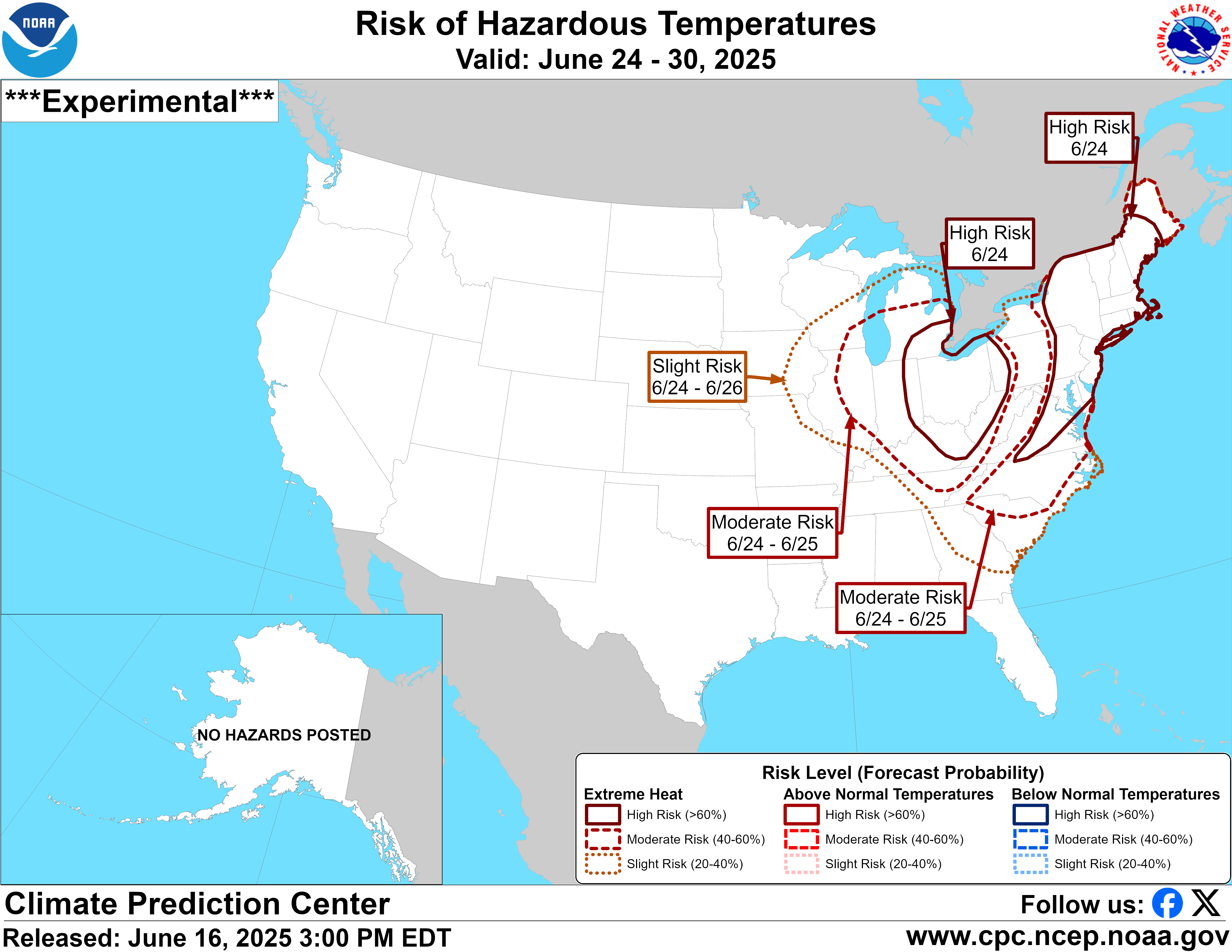
With corn racing higher the last 2 days, it's time to talk about this extremely important factor in determining corn yields.
Most are aware that July pollinating weather is extremely important for corn yields.
However, often even MORE important are temperatures AFTER pollination. The cooler it is, the longer it takes for the plant to mature and the more time it has to fill kernels. Hot weather(accelerated GDDs) causes the plant to mature rapidly and less time to fill kernels.........the dreaded HEAT FILL.
Cool weather during filling = plump kernels
Hot weather during filling = small kernels........even with ample rains
Very cool and slightly below average rain is better for corn yields in August than HOT weather and tons of rain.
This is just my statement below to demonstrate the principle. Producers should chime in with their actual experiences.
In August(or after pollination):
1. 4 degrees below average temps and 1 inch below average rain is better than
2. 4 degrees above average temps and 3 inches above average rain.
The 8 degree temperature difference is more significant than the 4 inch rain difference.
This is the EXCEPTION to the saying that "Rain makes Grain".
Lots of rain and heat are good............until the plant hits pollination.
And the heat is more than daytime readings in the 90's. If the lows at night stay well into the 70's with high humidity the plant is hurt even more.
I've added the best of recent heat fill posts below:
Re: Crop conditions August 1, 2022
By metmike - Aug. 2, 2022, 10:33 p.m.
https://www.marketforum.com/forum/topic/87675/#87784
80% of the corn crop had pollinated as of this last Sunday, so that crop is now filling kernels.
..HIGH heat will kill yields because it causes maturity at such a rapid pace that it lessens the time for the plant to fill the kernels with all the energy that we grow/use corn for(to feed animals for instance)
Cool weather = plump kernels
Hot weather = small kernels
Ideal filling is:
1. COOL with ample rains
2. After that, COOL and dry.
3. After that HOT (heat fill) and wet.......which is not ideal at all, even with good rains.
4. The worst is HOT and dry.
Heat fill is always bad news, especially if some areas are dry.
Heat fill with good rains will feature a green, good looking plant from the window observation and good ratings. But hidden inside of the husk, (until harvest) are rapidly filling kernels that are SMALL compared the exact same stage of the corn plant with COOL temperatures, along with GDD's and heat units accumulating at a slower pace.
Here are some links to past posts about heat fill. I added the best info below that so you don't have to go searching thru all that.
https://www.marketforum.com/forum/topic/86953/#87109
https://www.pioneer.com/us/agronomy/high-night-temps-yield.html

Figure 1. Daily minimum temperatures (7-day moving average) for Des Moines, IA, in 2009 and 2010, and 30-yr average minimum daily temperatures (1981-2010). Approximate dates of 10%, 50%, and 90% silking in Iowa in 2009 and 2010 based on USDA crop progress reports.


Figure 2. Average minimum temperatures experienced in July-August of 2009 (top) and 2010 (above) and average yields (bu/acre) in Iowa, Illinois, Missouri, Kansas and Nebraska. Data from NCEI NOAA, USDA NASS.
+++++++++++++++++++++++++++++++++++++++++++ICM News
by Roger Elmore, Department of Agronomy
"October corn yield forecast for Iowa dropped to 169 bushels per acre, a significant reduction from the August and September forecasts of 179 bushels per acre (see October USDA-NASS forecast). If realized, 2010 yields will rank sixth among the last seven years, higher only than the yields of 2006 (166 bushels per acre). Numerous published and anecdotal yield reports substantiate lower than expected yields this year.
In previous 2010 Integrated Crop Management News articles, we've addressed 2010 conditions and the possibility of reduced yields resulting from rapid crop development following silking (see September 28 article). Statewide Growing Degree Day accumulations were 116 percent of normal during most of the seed fill period — silk to dent — this year."
Table 2. Effect of temperature on grain fill duration, grain weight per plant and kernel number (Badu-Apraku et al., 1983).

https://agcrops.osu.edu/newsletter/corn-newsletter/warm-nights-may-impact-corn-yield
+++++++++++
This also applies to wheat and barley yields and heat fill.
https://pubmed.ncbi.nlm.nih.gov/26111197/
If you have nothing better to do, here are some previous posts to read on heat fill (-:
https://www.marketforum.com/forum/topic/74802/
Corn Yields
Started by metmike - Sept. 12, 2021, 12:01 p.m.
Corn is a crop that simply does NOT like abnormal heat in the summer...no matter what rainfall is like. That theory will be put the test again this year...as the chart below shows. Note that a sub-normal national corn yield this year would be 177.2 bpa or lower.
Heat fill for corn August 22, 2021
Started by metmike - Aug. 22, 2021, 8:31 p.m.
https://www.marketforum.com/forum/topic/74068/
Heatfill coming up for corn
Started by metmike - June 25, 2020, 7
https://www.marketforum.com/forum/topic/54571/
Heat Fill for corn
Started by metmike - Aug. 14, 2019, 5:51 p.m.
https://www.marketforum.com/forum/topic/36888/
https://www.marketforum.com/forum/topic/54571/#54578
https://cropwatch.unl.edu/how-extended-high-heat-disrupts-corn-pollination-0
"Even with adequate moisture and timely silking, heat alone can desiccate silks so that they become non-receptive to pollen. While this is a bigger problem when humidity is low, it is apparent that it is happening this year, especially on hybrids that silk quite early relative to pollen shed. Even with dew points in the 70s, when temperatures reach the high 90s to the100s, the heat can still desiccate silks and reduce silk fertility.
Heat also affects pollen production and viability. First, heat over 95°F depresses pollen production. Continuous heat, over several days before and during pollen-shed, results in only a fraction of normal pollen being formed, probably because of the reduced sugar available. In addition, heat reduces the period of pollen viability to a couple hours (or even less). While there is normally a surplus of pollen, heat can reduce the fertility and amount available for fertilization of silks. It's been shown (Herrero and Johnson, see Resources) that prolonged exposure to temperatures reduced the volume of pollen shed and dramatically reduced its viability."
According to Elwin Taylor, Iowa State University (ISU) climatologist, and Roger Elmore, ISU crop production agronomist, we are seeing an oscillating weather pattern where above normal temperatures east of the Continental Divide are likely to persist for up to six weeks. In the past, such patterns have been consistently associated with below trend corn yields for the U.S.
The insidious part of this pattern is that extended periods of heat tend to diminish yields even more. When soil moisture is sufficient, one day of 95-98°F has little or no impact on yields. However, after the fourth consecutive day there tends to be a 1% loss in yield for each day above that temperature. After the fifth or sixth day, there tends to be even greater potential for yield loss. While it is difficult to make yield loss predictions from heat and drought stress in any year, the stress does add up and take a toll on the crop."
Re: Re: Heat fill Summer coming up for corn?
By metmike - June 25, 2020, 8:30 p.m.
metmike: It appears that temperatures of 95 or less with ample moisture would have no deleterious affects on pollination. That is not so clear with Upper 90's and hotter, although those are HIGH temperatures and early in the day conditions would be cooler than that and more favorable to accomplish pollination.
• Long stretches of high temperatures may affect corn pollination.
• Hot weather can reduce viability, production, and the release of pollen grains.
• Silk viability can be reduced under extreme high temperatures before pollen shed.
• Timing of pollen shed, silking, and hot temperatures play a role in how heat affects the pollination process.
Here we go! Not good for early corn kernel filling.
Extended weather.
https://www.cpc.ncep.noaa.gov/products/predictions/610day/ | |||||||||
| 6 to 10 day outlooks | |||||||||
| Click below for information about how to read 6-10 day outlook maps Temperature Precipitation | |||||||||
| Click below for archives of past outlooks (data & graphics), historical analogs to todays forecast, and other formats of the 6-10 day outlooks ArchivesAnalogsLines-Only FormatGIS Data | |||||||||
Temperature Probability | |||||||||
Precipitation Probability | |||||||||
| |||||||||

more summer time yield affectors ///////......ozone, smoke...etc....but the bottom line....it depends, scientific answer there. Crops, esp corn need abundant sun light
Thanks for the awesome article, mcfarm!
Previous related thread:
Western Wildfires are back
Started by metmike - July 14, 2023, 11:06 p.m.